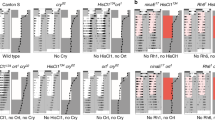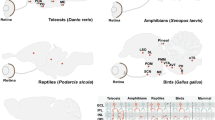Summary
The daily rhythm of behavioral activity inAplysia does not require the eyes as essential photoreceptors or essential driving oscillators; activity can be diurnal in lightcycles (Figs. 1, 2) and can freerun in constant darkness (Fig. 2) after the eyes have been surgically removed. The eyes, however, do play a role in modulating the activity rhythm; eye removal may change the temporal distribution of diurnal activity; reduce the punctuality of activity onsets, increase the amount of nocturnal activity, and decrease the total amount of activity (Fig. 1). These results, together with previously published ones, make it unlikely that a circadian oscillator known to reside in the eye and another one located in the abdominal ganglion are the sole sources of behavioral rhythmicity inAplysia.
Similar content being viewed by others
References
Arvanitaki, A., Chalazonitis, N.: Excitatory and inhibitory processes initiated by light and infra-red radiations in single indentifiable nerve cells (giant ganglion cells inAplysia). In: Nervous inhibition, Florey, E., Ed. New York: Pergamon Press 1961.
Bullock, T. H., Horridge, G. A.: Structure and function in the nervous system of the invertebrates. San Francisco: Freeman and Co. 1965.
Eskin, A.: Properties of theAplysia visual system.In vitro entrainment of the circadian rhythm and centrifugal regulation of the eye. Z. vergl. Physiol.74, 353–371 (1971).
Jacklet, J. W.: A circadian rhythm of optic nerve impulses recorded in darkness from the isolated eye ofAplysia. Science164, 562–564 (1969).
Kupfermann, I.: A circadian locomotor rhythm inAplysia californica. Physiol. Behav.3, 179–182 (1967).
Lickey, M. E.: Seasonal modulation and non-24 hour entrainment of a circadian rhythm in a single neuron. J. comp. physiol. Psychol.68, 9–17 (1969).
Lickey, M. E., Emigh, R. L., Randle, R. R.: A recirculating seawater aquarium system for inland laboratories. Marine Biol.7, 149–152 (1970).
Lickey, M. E., Zack, S.: Role of the eyes for entrainment inAplysia, I: circadian rhythm in the abdominal ganglion. J. comp. Physiol.84, 361–366 (1973).
Lickey, M. E., Zack, S., Birrell, P.: Some factors governing entrainment of a circadian rhythm in a single neuron. In: Biochronometry, Menaker, M., Ed. Washington, D. C.: National Academy of Sciences 1971.
Lukowiak, K., Jacklet, J. W.: Habitation: A peripheral and central nervous system process inAplysia. Fed. Proc.31, 405 Abs (1972).
Menaker, M.: Rhythms, reproduction and photoreception. Biol. of Reproduction4, 295–308 (1971).
Newby, N.: Habituation in light and spontaneous activity in the isolated siphon ofAplysia: The effects of synaptically active pharmacological agents. Ph. D. Diss., Case Western Reserve Univ. 1972.
Nishiitsutsuji-Uwo, J., Pittendrigh, C. S.: Central nervous control of circadian rhythmicity in the cockroach. II. The pathway of light signals that entrain the rhythm. Z. vergl. Physiol.58, 1–13 (1968).
Pittendrigh, D. S., Bruce, V. G.: Daily rhythms as coupled oscillator systems and their relation to thermoperiodism and photoperiodism. In: Photoperiodism and related phenomena in plants and animals, Withrow, R. B., Ed. Washington, D. C.: A. A. A. S. 1959.
Richter, C. P.: Biological clocks in medicine and psychiatry. Springfield, Illinois: Charles C. Thomas 1965.
Stephan, F., Zucker, I.: Circadian rhythms in drinking behavior and locomotor activity of rats are eliminated by hypothalamic lesions. Proc. nat. Acad. Sci. (Wash.)69, 1583–1586 (1972).
Strumwasser, F.: The demonstration and manipulation of a circadian rhythm in a single neuron. In: Circadian clocks, Aschoff, J., Ed. Amsterdam: North-Holland Publishing Co. 1965.
Strumwasser, F.: Neurophysiological aspects of rhythms. In: The neurosciences, Quarton, G., Melnechuk, T., Schmitt, F. O., Eds. New York: Rockefeller University Press 1967.
Strumwasser, F., Schlechte, F. R., Bower, S.: Distributed circadian oscillators in the nervous system ofAplysia. Fed. Proc.31, 405 Abs (1972).
Author information
Authors and Affiliations
Additional information
Financial support by USPHS NIH. We thank Monique Prevost for typing the manuscript and Joan Wozniak for technical assistance.
Rights and permissions
About this article
Cite this article
Block, G.D., Lickey, M.E. Extraocular photoreceptors and oscillators can control the circadian rhythm of behavioral activity inAplysia . J. Comp. Physiol. 84, 367–374 (1973). https://doi.org/10.1007/BF00696349
Received:
Issue Date:
DOI: https://doi.org/10.1007/BF00696349




